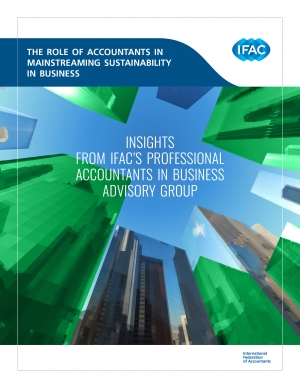عرض العناصر حسب علامة : تكنولوجيا
ماذا يفعل المحاسب اليوم؟
لم تتغير المحاسبة منذ مئات السنين، لكن دور المحاسبين تغير. بدلاً من أن يتم استبدالهم بالتكنولوجيا، أصبح المحاسبون أكثر قيمة من أي وقت مضى.
معلومات إضافية
-
المحتوى بالإنجليزية
Accounting hasn’t changed for hundreds of years, but the role of accountants has. Instead of being replaced by technology, accountants are more valuable than ever.
Knowing how accountants can fully contribute their skills in today’s modern work environment not only unleashes their potential but also increases their value to your organization. Let’s look at how technology and data have changed and revitalized the accountant’s role.
WHAT DO ACCOUNTANTS DO TODAY?
What Does an Accountant Do Today?
Today, the accountant is the curator of your financial data. This role is growing to be more tech-savvy in how they gather and analyze data to help you lead and grow your business. Cloud-based accounting technology is the key component of this shift. The three innovations heavily influencing cloud accounting today are: the Cloud, APIs, and automation.
The Cloud
Instead of downloading and managing accounting solutions internally, remote servers run by the software provider let you use the solution whenever, wherever you want. This means that accountants can now be totally remote-based just as easily as onsite. Cloud accounting has made it possible for financial professionals to have real-time data to analyze and help you make the best decisions possible for your business at all times.
APIs
Without application programming interface (API), integration and IT flexibility would be impossible. This is what allows different software to communicate and share data between solutions. Because of this, APIs are a critical component of cloud architecture and cloud accounting. One of the leading benefits of cloud-based technology is that you can link your other business applications on the Cloud to the accounting system. Nobody wants to spend hours and money manually entering accounting details and then re-checking them. To prevent this and secure streamlined accounting, resilient API is a must.
Automation
Click a button and a task, or several tasks at once, are completed immediately. Automation is making accounting faster, more reliable, and less dependent on manual data entry than ever before. For accounting, this means less tedious bookkeeping and more data analysis by accountants to help you grow.
As manual entries and accounting processes get faster and less-demanding, accountants are freed to serve more as guides or consultants rather than just crunching numbers. Therefore, the accountant’s value has increased. With their shrewd financial insight, businesses gain clearer, faster information needed to achieve the greatest return-on-investment for your business. Accountants are not at the mercy of modern technology, but rather have greater tools to take their role to the peak of its ability.
Accountants Today Rely On Data-Informed Accounting
Data is decisive, now more than ever, in such a fast-paced IT environment. In addition to overseeing transactions and consolidations, monitoring accounting data is important for maintaining your company’s financial health. Accountants are shifting to be more data-driven than before.
Transactions handling and general ledger accounting remain important functions. But now, greater focus is on more strategic tasks like cash flow reporting and project accounting. Everything in business has a financial dimension. Harnessing the latest technology, accountants can more clearly understand these dimensions to inform more accurate ways to consolidate revenue and manage expenses. They can more easily pinpoint what’s working for your company to increase revenue opportunities. Data doesn’t lie!
Accountant-Centric Accounting Software
When you look into accounting solutions, really consider how it will let your accountants collect, visualize, and analyze financial data. Your system should help them do their job without skipping a beat. Here are a few key considerations when looking for the best accounting system for accountants to utilize.
Does the system provide an audit trail function to track specific information?
Is the accounting platform easy to use and adaptable to business needs?
How efficient are accounting processes?
What’s the level of automation?
How flexible and robust are the reporting features?
رسالة دكتوراه: الأثر المحاسبي لخصائص تكنولوجيا سلاسل الثقة Blockchain على كفاءة سلاسل التوريد
تناولت هذة الدراسة الأثر المحاسبي لخصائص تکنولوجيا سلاسل الثقة Blockchain المتمثلة في خاصية التحقق والمشارکة والتتبع والقابلية للبرمجة علي کفاءة سلاسل التوريد
معلومات إضافية
- البلد مصر
اتجاهات المحاسبة في الغد
معلومات إضافية
-
المحتوى بالإنجليزية
In our lifetimes, we’ve all seen technology accelerate every industry it touches. Based on my more than 20 years of experience working in the accounting tech industry, I’ve witnessed this transformation firsthand. Most accountants already use digital tools and are optimizing processes to go paperless. Yet as technology continues to advance and further automate numerous functions, conversations turn to the prospect of human-less accounting.
Will Accountants Be Replaced By Robots?
The short answer is no. Discussions of a robot revolution are honestly more sensational than factual. In the real world, the technologies transforming the financial industry will in no way render the human factor redundant.
Instead, technologies like the cloud, artificial intelligence (AI) and blockchain will empower accountants -- and the entire financial services industry -- by reducing manual data entry and improving the speed, accuracy and quality of data.
PROMOTED
Accountants who embrace the trends below will have a greater capacity to advance their roles as trusted, value-added advisers and analysts -- rather than number-crunchers or the dreaded “bean counter.”
Harnessing The Power Of The Cloud
By 2026, the global market for accounting software will have a value of $11.8 billion (subscription required), according to Accounting Today. Digital is already a given in the accounting industry. With cloud accounting and software-as-a-service (SaaS) applications and the ability to access financial data from any internet-enabled device, virtualization is the new norm.
The growing ecosystem of applications that integrates with accounting platforms has also proven to be efficient by connecting and streamlining back-office processes for a wide range of businesses and industries.
A counterpoint to cloud adoption rates: Neither desktop nor enterprise software will be going away anytime soon. One of the greatest examples of this is while QuickBooks Online reached 2 million subscribers worldwide in 2017, there’s still a substantial user base for QuickBooks Desktop. Of those online subscribers, 80% are first-time users for any kind of accounting software. These users aren’t migrating from desktop to the cloud; they’re starting online. As the target users for QuickBooks Online are small to medium-sized businesses, accountants play a pivotal role in introducing businesses to the cloud.
Accelerating Automation
By 2020, labor-intensive tasks like tax preparation, payroll, audits and banking will be fully automated -- a trend that’s considered the greatest transformation since the introduction of double-entry bookkeeping 500 years ago.
Artificial intelligence (AI) and machine learning won’t make human intelligence extinct. What they’ll actually do is give accountants better access to a range of near-real-time information from a greater number of sources.
For example, a big-picture part of what one of my companies, PayPie, will be doing is using blockchain and smart contracts to exchange secure information between businesses and lenders. AI components will be used to verify the information and ensure that both parties see the information in near-real time.
While algorithms will continue to get more powerful and efficient at compiling big data, computers are only great transactional machines. They can’t replace the interpretive capacity of the human mind. It’s also pretty hard to teach a machine common sense.
Technology will give us access to better data, but accountants are the ones who’ll have to apply this information to the real world to provide crucial business insights and intelligence.
Breakthroughs Via Blockchain
Assuming that cryptocurrencies are the only use for blockchain is like thinking that binge-watching is the only use for online streaming. At the recent Accounting and Finance Show L.A., blockchain (subscription required) and smart contracts dominated conversations.
A single-ledger technology, blockchain is a delivery method that lets users from several sources access the same information in near-real time. For instance, if a business’ risk profile is hashed (tied) to the blockchain, the business and its potential lenders or investors can all access the profile simultaneously.
الروبوتات ليسوا محاسبين!
كُتب الكثير في العام الماضي عن أتمتة العمليات الروبوتية (RPA)، ولسبب وجيه. من خلال تسهيل التكامل الأوسع للأنظمة المالية المتباينة وتطبيقات البرامج، يُعد RPA مزيد من الكفاءة لمؤسسات التمويل والمحاسبة. ولكن هل الروبوتات بديل للمحاسبين كما أثبتت بعض المقالات؟
معلومات إضافية
-
المحتوى بالإنجليزية
Much has been written in the last year about robotic process automation (RPA), and for good reason. By facilitating broader integration of disparate financial systems and software applications, RPA promises more efficiency to finance and accounting organizations. But are robots a substitute for accountants, as some articles have attested? Not by a long shot.
RPA captures, manipulates and interprets transactional data flowing from myriad IT systems and applications, effectively taking these repetitive tasks from accountants. That’s a good thing, as it frees up the accounting staff to become strategic accountants. The “robots” liberate accountants to do what they have longed to do — make sense of the financial data to improve business decisions.
RPA is just the latest iteration in a long progression of F&A software tools designed to improve efficiency and data accuracy, including our own here at BlackLine. RPA extends the automated functionality of ERP systems beyond the range of application programming interfaces (commonly known as APIs) and simple object access protocol, which are used to integrate the ERP system with other IT applications. Instead of the customary weeks it takes to link these systems, RPA pares the time down to a matter of days.
Trends and Technologies Shaping the Future of Tax and Accounting
WOLTERS KLUWER
There are some studies, such as that by the Hackett Group, that suggest that automated tools may lead to a reduction in headcount. But robo-accountants are not actual accountants. Despite the enormous power and promise of digital solutions, there will always be a need for the human connection. Robots may replicate what people do, but they are unemotional, have no intuition and cannot be motivated in a common cause. They’re simply machines making routine work easier and more efficient.
Turning dislocation into transformation
Today’s accountants should not fear automation; rather, they should embrace these tools to become strategic accountants. When machines replace traditional forms of work, they simultaneously open the door to other options. People are liberated to be more creative, engaged and productive. Let the robots handle rote administrative processing. Accountants’ skills are far too nuanced to squander on such tasks.
A case in point is the competitive advantage of extracting deeper meaning from internal and exogenous financial data. The internet is inundated with millions of data sets that may have import in business decisions. Software can narrow the field, but someone has to interpret the data to determine where best to grow the business or pull back.
Accountants can perform this function, filtering and analyzing internal and exogenous business-related data to assist the CFO in making more informed and agile decisions. Armed with the accountants’ analyses, the CFO can make more astute bets on where to invest the company’s capital and where to restrict it.
The office of finance has always been the nexus of financial and other business-related data. In today’s blisteringly fast 24/7 global business environment, where change can happen overnight, this information is a vital currency that can improve market share, reduce strategic risks and widen margins. The problem is that CFOs have relied on purely historical business data in making resource allocation and other financial decisions. Accountants are an untapped resource to help make rapid sense of today’s numbers to ensure the company remains on course to achieve its strategic objectives. If this is not the case, the CFO has an enhanced opportunity to nimbly change direction to seize more profitable business opportunities elsewhere.
Do CFOs require such assistance? You bet they do. In a 2016 survey of 122 CFOs at large companies by Deloitte, the respondents stated that they spend more than one quarter (27 percent) of their time on company strategy. An equal amount of time is devoted to operations, identifying ways to improve organizational efficiency, balance costs and manage issues related to talent. Less than one quarter of the CFOs’ time is focused on traditional finance functions, such as accounting and financial reporting and control requirements.
رسالة ماجستير: انعكاسات التكامل بين تحليلات البيانات الضخمة ونظم تخطيط الموارد على تطور دور المحاسبين الإداريين وتحسين وظائف المحاسبة الإدارية
الغرض من الدراسة : تحديد الدور المحوري الذي يمکن أن يلعبه المحاسب الإداري في مساعدة الأعمال علي ترجمة رؤى البيانات الجديدة إلي قيمة للشرکة باستخدام تقنيات تصويرية متعددة والترکيز علي المهارات التي يجب أن تتوافر لدي المحاسب الإداري
معلومات إضافية
- البلد مصر
رسالة ماجستير: تقييم أثر العلاقة بين تطبيق نظم تخطيط موارد المنشأة ERP وقيمة المنظمة
ترجع أهمية الدراسة إلى ما يشهده العالم الآن من تطور هائل في نظم تکنولوجيا المعلومات وسعي المنشآت الدائم نحو الإستخدام الأمثل لکافة الموارد المتاحة
محاربة الاحتيال في بيئة عمل هجينة
يأتي مع بيئات العمل الهجينة الجديدة لدينا إيجابيات وسلبيات. في مهنة المحاسبة على وجه التحديد، يؤدي تطبيق التكنولوجيا الجديدة إلى عمليات أكثر كفاءة، ولكن يمكن أن يؤدي أيضًا عن غير قصد إلى مخاطر إضافية مثل الاحتيال.
معلومات إضافية
-
المحتوى بالإنجليزية
Fighting fraud in a hybrid work environment
By Vinay Pai
December 17, 2021, 9:00 a.m. EST
4 Min Read
Facebook
Twitter
LinkedIn
Email
Show more sharing options
With our new normal of hybrid work environments come both pros and cons. Specifically in the accounting profession, the implementation of new technology creates more efficient processes, but can also inadvertently lead to additional risks such as fraud.
While all industries face privacy and data security challenges in hybrid environments, the sensitive and confidential information in accountants’ routine work demands a higher level of cybersecurity to ensure that all client data is totally secure. It is essential that accountants remain vigilant for possible fraud and actively safeguard network systems to ensure continued strategic growth for small and midsized businesses.
How does fraud happen?
Advances in Tech brings together some of the latest software and technologies that are helping the industry move forward.
ACCOUNTING TODAY
Fraud can occur in many ways. While the concept of physical fraud risks may seem outdated (especially in hybrid environments), the majority of confidential data — such as Social Security numbers and credit card information — is still stolen the “old-fashioned” way, via theft of physical laptops or important documents (e.g., paper checks, invoices, sticky notes) from unsecured areas. Even with the potential of artificial intelligence to reduce the burden and risk of many manual processes, many accountants and bookkeepers are still remarkably reliant on paper with 40% of bookkeepers still printing and mailing checks.
Hybrid and remote work models have also exacerbated many existing cybersecurity risks for many accounting firms. In the early days of the pandemic — when the transition to remote work needed to happen essentially overnight — it wasn’t uncommon for firms to put necessary “Band-Aid” solutions in place. Many companies and accountants moved their data to the cloud for the first time, which is a positive development, but not a silver bullet to safety.
Phishing attempts have continued to rise, preying on the stress of employees and owners, and the lack of updated protections and employee education as they managed through a crisis. These deceiving emails and notes, often disguised as emails from colleagues, are one of the most common ways that hackers can gain access to even the most secure networks. Now is the time to refine and improve those new processes put into place over the past two years, prioritizing more secure practices and the safeguarding of sensitive data.
Preventing fraud
There are a variety of practices that firms can implement to mitigate the risks of fraud in hybrid work environments. From a data security perspective, it starts with the cloud.
Cloud-based solutions and Software-as-a-Service providers are the most secure way to store client data, as these systems have more secure encryption methods than what accounting firms can offer in-house. This also removes the risk of stolen computers from a “smash and grab” robbery. While it’s now generally accepted that storing data in the cloud is far more secure than relying on a paper trail, decentralized personnel and the lack of pre-developed protocols for remote work left many firms exposed to additional cyber risks from unsecure networks and personal devices.
Going forward, accounting firms should ensure that all accountants are trained on an ongoing basis in the best cybersecurity practices while in a hybrid environment, including how to identify, prevent and address all types of fraud threats, from physical to digital. Employees should be vigilant about diversifying their passwords, keeping their login credentials private and updating them regularly.
It’s also critical to use secure devices and networks, implementing multifactor authentication for all services, and software to monitor for phishing and other scams. Lastly, with the rise in popularity of automated workflows to process data and transactions in daily accounting practices, accounting firms should consider investing in and implementing AI systems that scan for mistakes, such as duplicate payments, fraud — and even basic human error.
Strengthening tech security
In light of many major players in the accounting profession embracing more permanent hybrid and remote work models, accounting firms of all sizes should identify what, if any, interactions really require paper or physical interaction. For practices (such as accounts payable and payroll) that can easily be digitized, accounting firms should ensure they’re supporting those practices through secure, online systems and cloud-based storage solutions to ensure the highest levels of data protection.
Additionally, for communication with clients, firms should establish secure portals for the transfer of sensitive documents that contain personal or sensitive information, such as Social Security numbers, bank account information and credit card details. Never send these documents over email. A cloud-based document sharing solution is much more secure. All-in-one SaaS solutions that allow you to manage your workflow, approvals and payments can provide high security and convenience in hybrid environments.
Prior to the pandemic, many accounting processes were based primarily on physical work models and paper-based processes, but the acceleration of flexible and remote work models has only increased the overdue need for accountants to embrace automated technologies and AI-enabled workflows.
As firms seek to implement new workflows, it’s essential to prioritize educating the teams about how to mitigate new and emerging fraud risks and secure data on cloud-based servers before the Trojan horse is wheeled through the front gates.
ما هو نظام تخطيط موارد المؤسسة ولماذا تحتاجه؟
ERP هو اختصار يرمز إلى برنامج تخطيط موارد المؤسسة يعتبر برنامج لإدارة عمليات الأعمال حيث يدير ويدمج البيانات المالية للشركة، وسلسلة التوريد، والعمليات، والتجارة، وإعداد التقارير، والتصنيع، وأنشطة الموارد البشرية. تمتلك معظم الشركات شكلًا من أشكال النظام المالي والتشغيلي، ولكن معظم البرامج الموجودة لا يمكنها تجاوز العمليات التجارية اليومية أو المساعدة في نمو الأعمال في المستقبل.
معلومات إضافية
-
المحتوى بالإنجليزية
What is ERP and why do you need it?
ERP is an acronym that stands for enterprise resource planning (ERP). It’s a business process management software that manages and integrates a company’s financials, supply chain, operations, commerce, reporting, manufacturing, and human resource activities. Most companies have some form of finance and operational system in place but most of the software that’s out there can’t go beyond everyday business processes or help with future business growth.
As company’s needs change and they expand, their systems should keep up with them. We’ll define what ERP is and why it’s smart to have software in place that keeps up with your business needs.
What is enterprise resource planning? Yesterday and today.
Historically, ERP systems were monolithic suites that that worked separately and didn’t talk with other systems. Each system required expensive, complex, and customized code to meet unique business requirements which slowed—or even prevented—the adoption of new technology or process optimization.
What makes today’s ERP software different is that it brings all these different processes to the table and together in one fluid system. And not just offering data connectivity within your ERP system, but also within your productivity tools, e-commerce, and even customer engagement solutions. Helping you connect all your data for better insights that help you optimize your processes across your entire business.
In addition, a modern ERP solution offers flexible deployment options, improved security and privacy, sustainability, and low-code customization. But most importantly, it will build continuity and resiliency into your business and processes through insights that help you innovate at a rapid rate today while preparing your business for what’s next tomorrow.
Why ERP is critical for your businesses
While there’s no all-up solution software for every business process, ERP technology is getting better and better at bringing processes together. Once your processes, systems, and data are connected, you’ll get the intelligence, acceleration, and adaptability you need to start optimizing your operations.
Here’s three ways ERP can improve your business:
1
Drive optimal performance
With solutions that integrate artificial intelligence (AI), you’ll access insights that enhance your decision making and reveal ways to improve operational performance going forward.
2
Accelerate operational impact
By connecting processes and data, you’ll bring more visibility and flexibility to employees to help them take action quickly and deliver more value across the business.
3
Ensure business agility
Many ERP solutions are built to adapt to your needs and grow with you, helping you proactively prepare for—and readily respond to—any operational disruption or market change.
What business functions benefit from ERP?
ERP can cover many core functions across your organization—helping break down the barriers between the front office and back office while offering the ability to adapt your solution to new business priorities. Some of the key business functions include:
Commerce
Today’s retailers face many challenges and an ERP system can deliver a complete, omnichannel solution that unifies back-office, in-store, and digital experiences. Customers will get a more personalized and seamless shopping experience through AI recommendations, while retailers are able to increase employee productivity, help reduce fraud, and grow their business.
Finance
Modern ERP will help you increase profitability while driving compliance. It offers dashboards and AI-driven insights that give you an overview of your finances to help you tap into the real-time information anytime and anywhere. It should also help you cut down on entering information manually by automating daily tasks and include tracking abilities that help with your business’s regulatory compliance.
Human resources
Modern solutions offer ways to manage company data and streamline employee management tasks like payroll, hiring, and other duties. You’ll be in a better position to help retain, recruit, and empower employees while also tracking employee performance and identifying HR problems before they happen.
Manufacturing
This function improves business communication, automates daily processes through robotic process automation, and offers manufacturers the ability to fulfill customer needs and manage resources by accessing real-time data. This solution also optimizes project and cost management as well as production planning.
Supply chain
If your company is still entering information by hand and trying to track down inventory in your warehouse, you can easily save time and money by automating these processes with ERP. Modern solutions also offer dashboards, business intelligence, and even Internet of Things (IoT) technology to help you get a handle on your inventory management.
Three signs that you need ERP
If you’re reading this and struggling with your legacy system, you probably already know that implementation is in your future, but here are the signs that you definitely need new ERP starting today:
1
The basics aren’t letting you grow
Perhaps you’ve been doing fine with basics, but if your current software is putting limits on your market expansion and ability to grow on a global scale, it may be time for a better ERP system that does.
2
You’re dealing with disparate systems
As technology changes, you’re noticing that your disparate systems don’t work well together. You may notice that your new accounting software isn’t compatible with your old HR system, and you’re tired of wasting time and resources trying to stitch a solution together.
3
You can’t meet customer expectations
If your staff and customers are mobile and your system isn’t accommodating them, it’s time to invest in one that meets everyone’s needs. If you feel like you can’t afford to invest in meeting your customer’s expectations, and you’re not willing to give your staff the tools they need to succeed, you’ll lose them to a competing business pure and simple.
TIP:
If you or your staff is asking for a new system and there’s a resistance to an ERP change, one of the ways to combat this is to schedule a demo so everyone can see what’s out there. Plus, when everyone feels like they’re included in on the decision process it’ll make implementation much easier.
Why some businesses are afraid to embrace ERP implementation
Despite all the options out there, some companies are still hesitant about implementing ERP. There could be many reasons why, but where there’s a fear, there’s a solution.
FEAR: How do I know I’m choosing the right ERP solution for my business?
You don’t have to find the perfect software solution to fix everything. ERP should actually be able to take the best of the business processes you’re using now and bring them together under one system, while letting everyone in your organization view the same information. This is where your choice of at technology partner is important.
FEAR: We can’t afford a major ERP overhaul.
A solution doesn’t have to be an all or nothing implementation proposition. Software solution modules can be purchased separately depending on your business needs. This will help your team ease into the implementation piece of ERP and it’ll save having to invest in a major software renovation without knowing whether or not the functions you’re adding will pay off.
FEAR: We don’t want to lose the systems we have in place now.
As we mentioned, any ERP solution you choose should work with what you’re using now but also include features that can help in your future growth. For instance, if the software you have mostly handles the financial, supply chain, and manufacturing sides of your business, you may want to look for a solution that brings in a strong business intelligence component.
Discover what modern ERP can do for your business
Now that you’ve got a good grasp on what ERP is, discover the ways that Microsoft Dynamics 365 brings the best of what modern enterprise resource planning has to offer your business—modular, end-to-end business applications that connect all your data for continuous insights that help you rapidly respond to change so you’re future-ready.
دور المحاسبين في تعميم الاستدامة في الأعمال
يتطلب تحقيق الاستدامة انتقال التكنولوجيا والابتكار ويمكن أن يؤدي إلى اضطراب. العقلية المتكاملة هي المفتاح.
معلومات إضافية
-
المحتوى بالإنجليزية
Achieving sustainability requires technology and innovation to transition and could be disruptive. An integrated mindset is key.
At its October 2021 virtual meeting, IFAC’s Professional Accountants in Business Advisory Group considered how accountants are contributing to value creation and sustainability in their organizations in both the private and public sectors. The report, The Role of Accountants in Mainstreaming Sustainability in Business, summarizes the key insights and learnings from the discussions amongst this global group of business and finance leaders, drawing from their diverse experiences and expertise.
Having an integrated approach to financial and sustainability-related information under the remit of the CFO was a key topic of discussion. This leads to better decisions that deliver long-term value to stakeholders and society, while also ensuring financial returns to investors. The group also explored ways the potential opportunities offered by digital assets, including to improve efficiencies, increase transparency, and spur innovation towards societal goals, could gain legitimacy.
“The need for CFOs and finance functions to contribute strategically as value partners is increasing to advance sustainability,” said Sanjay Rughani, PAIB Advisory Group Chair. “By sharing our learnings as a profession, we can continue to elevate our focus and actions on higher value activities to support and empower more professional accountants to take on increasingly strategic roles.” - البلد الأردن
مستقبل الميزة التنافسية في الأعمال المصرفية والمدفوعات
تتزايد الإمكانات التخريبية للتكنولوجيا في قطاع الخدمات المالية بمعدل غير مسبوق لمنح الصناعة ميزة تنافسية
معلومات إضافية
-
المحتوى بالإنجليزية
The future of competitive advantage in banking and payments
The disruptive potential of technology within the financial services sector is increasing at an unprecedented rate to give the industry a competitive edge
by Alara Basul | November 1, 2021 | Bottomline
As financial firms turn to new solutions to stay competitive against the bleak backdrop of the global pandemic, there’s no surprise to see an increase in adoption across digital technologies, real-time payments and digital transformation. Businesses have had to prioritise their strategies in order to gain a competitive market advantage and stay compliant amid new regulations.
Bottomline’s latest report, The Future of Competitive Advantage in Banking and Payments, highlights the effects of the global pandemic and outlines the key components for banks and financial institutions (FIs) to remain competitive against the drive towards real-time payments, key regulations and trends, and consumer expectations towards speed, agility, and fraud protection.
Digital transformation and addressing innovation
For the banking industry, competition in the short term will depend on a successful digital transformation, as the overwhelming feedback from banks and FIs report that institutions require a greater focus on digital-centric solutions and better support internally from the top-down to accelerate change.
Sixty-four percent of respondents reported that digital transformation is the biggest objective for their business, followed by 41 percent reporting real-time payments, and 37 percent reporting cross-border payments as their main focus.
Digital transformation, real-time payments & cross border transactions are all closely linked as legacy systems require to be updated for real-time rails. Yet, nearly a fifth of banks and FIs (19 precent) are “somewhat sceptical” about their firm’s efforts towards creating a successful and modernised strategy.
Transitioning to a payments ecosystem
Connected finance was one of the key themes and takeaways from this report. Businesses recorded that 76 percent have a strong or extremely strong appetite to transition towards a payments ecosystem over the next five years, suggesting a strong use case for having an aggregated connectivity solution.
Respondents also confirmed that the biggest issues around their current payments infrastructure were legacy systems (47 percent), followed by the lack of operational efficiency (40 percent).
Lack of interoperability between internal systems ranked third, which ties back to the lack of operational efficiency as well as legacy infrastructure systems.
“Banks globally recognise the need for digital transformation as their end user expectations change,” says Gilles Ubaghs, strategic advisor, commercial banking & payments, Aite-Novarica Group.
“Putting off digital transformation is no longer an option as the Covid-19 pandemic has dramatically accelerated this shift, changing end user expectations, and is now changing the competitive landscape.”
Perhaps the most surprising discovery from the report is that despite the strong push towards payments modernisation, banks and FIs haven’t factored in the benefits of the payments ecosystem being SaaS rather than on-premise – only 31.5 percent saw migrating to cloud or SaaS technology as a top priority over the next 12 months.
Barriers to adoption
The payments industry has faced rapidly evolving technologies and adoptions of new services around real-time payments. It’s apparent from the findings that businesses that don’t provide real-time payments functionalities risk attrition and falling behind the curve.
And the growth of real-time payments is setting new records; in 2020, a record 70.3bn transactions were processed, up 41 percent from 2019, and is estimated to be on track to hit a 23.6 percent annual clip for the next five years.
By 2025, it’s also estimated that Real-time Payments (RTP) will have a 17.4 percent share of global payments.
However, it’s evident that with the ongoing global pandemic, businesses have found it difficult to prioritise their efforts on ramping up their offerings of digital payments in an already-busy roadmap of transformative initiatives.
Difficulties around adopting a legacy infrastructure ranked second among respondents (36 percent), followed closely by lack of IT resources (34 percent).
Banks & FIs have had to overhaul their business efforts from a regulatory and industry compliance point of view to keep pace with ISO 20022, SWIFT CSP, Confirmation of Payee and PSD2. The report highlights how leveraging real-time data, incorporating insights and analytics, and adopting a clear real-time payments strategy could be the difference between strengthening the customer experience and stemming attrition.
“The profitability of the payments business stands at a crossroads. The combined forces of fierce competition, regulatory interventions, and necessary investments in infrastructure and compliance put operating margins under pressure,” said Ron van Wezel, strategic advisor, retail banking & payments, Aite-Novarica Group.
“At the same time, the pandemic has boosted the adoption of digital payments, creating new opportunities for banks and other payment companies.”
Implementing ISO 20022
The report states that 13 percent of banks and FIs have implemented ISO 20022 to date, 15 percent are mid-way through implementing and 13 percent have already completed their implementation. However, 23 percent of respondents said that their businesses have just started preparations, with 25 percent noting that they have not yet started.
These figures show that many banks are under pressure or presumably facing the underestimated complexity of the migration and find it difficult to attain the right resources after understanding that the transition isn’t a simple upgrade of process.
SWIFT currently has 17 million payment messages exchanged each day, with numbers set to increase dramatically and imminently, so it’s imperative for businesses to get up to speed on the integration and transition required as soon as possible.
Navigating cross-border payments
Cross-border is a topic filled with regulation but critical to the health and success of any FI, especially in the EU.
Thirty-one percent of banks and FIs reported that the greatest obstacle to successful cross-border payments is the cost of maintaining so many ‘nostro’ accounts.
Other key pain points include issues with the slow or unknown speed for arrival of cross-border payments (21 percent), and the lack of visibility on payment status (24 percent). Furthermore, eight percent of respondents are also concerned about poor quality or loss of data.
It’s clear that there is now a need more than ever to reimagine the role of technology within the banking and financial sector, and it’s imperative for businesses to understand how to utilise new platforms and understand the impacts of new regulations in order to stay competitive and compliant in a crowded market.
To find out more about the research from The Future of Competitive Advantage in Banking & Payments, download the full report here. - البلد الأردن










